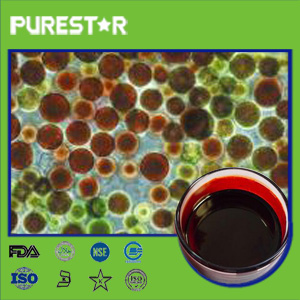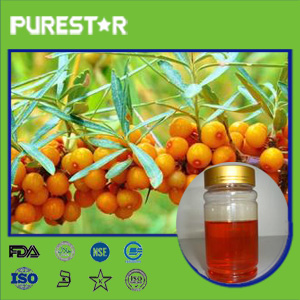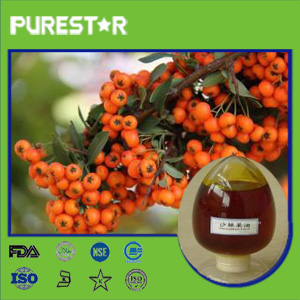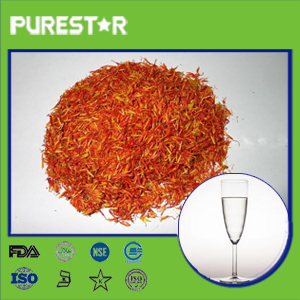CATEGORIES
LATEST NEWS
CONTACT US
- ADD: No.235,Huanchengdong Road,Huzhou,Zhejiang,China
- TEL: 0086-572-2157374
- FAX: 0086-572-2146389
- E-mail: sales@plantextractpowder.com



Astaxanthin Oil
- Botanical Source: Haematococcus pluvialis
- Specification: Astaxanthin Oil 5%, 10%
- CAS No. :472-61-7
- Appearance:Dark Red Oil
- Product description: Huzhou Purestar Biochem Co.,Ltd is provide the reliable quality Astaxanthin Oil with ISO,KOSHER,HALAL.
PRODUCT INTRODUCTION
Astaxanthin Oil
Product Name:Astaxanthin
Botanical Source: Haematococcus pluvialis
Molecular Formula: C40H52O4
Molecular Weight: 596.85
Molecular Weight:596.85
CAS No.:472-61-7
Specification:1%-10% assay by HPLC
Molecular Formula:C40H52O4
Appearance :Dark Red Oil
Description of Astaxanthin Oil
What is astaxanthin?
Astaxanthin (pronounced as-tuh-zan'-thin) is a carotenoid. It belongs to a larger class of phytochemicals known as terpenes. It is classified as a xanthophyll, which means "yellow leaves". Like many carotenoids, it is a colorful, lipid-soluble pigment. Astaxanthin is produced by microalgae, yeast, salmon, trout, krill, shrimp, crayfish, crustaceans, and the feathers of some birds. While astaxanthin is a natural nutritional component, it can be found as a food supplement. The supplement is intended for human, animal, and aquaculture consumption. The commercial production of astaxanthin comes from both natural and synthetic sources. The U.S. Food and Drug Administration (FDA) approved astaxanthin (See: Regulations below) as a food coloring (or color additive) for specific uses in animal and fish foods. The European Union (actually European Commission) considers it food dye within the E number system, E161. In 1948, Nobel prizewinner George Wald surmized, "This could lead to an important new use of astaxanthin as a drug delivery for medicines that are insoluble in water, and give designers of new food colourants or dyestuffs an interesting new capability." Astaxanthin is used as a feed supplement for salmon, crabs, shrimp, chickens and egg production. Regardless of the source, astaxanthin provides some important benefits beyond coloration. It also has been found to be essential for proper growth and survival. For seafood and animals: The primary use of synthetic astaxanthin today is as an animal feed additive to impart coloration, this includes farm-raised salmon and egg yolks. In that, synthetic carotenoid (i.e., coloured yellow, red or orange) pigments represent about 15-25% of the cost of production of commercial salmon feed. Today, essentially all commercial astaxanthin for aquaculture is produced synthetically from petrochemical sources, with an annual turnover of over $200 million, and a selling price of ~$2000 per kilo of pure astaxanthin. For humans: Currently, the primary use for humans is as a food supplement. Research shows that due to astaxanthin's potent antioxidant activity, it may be beneficial in cardiovascular, immune, inflammatory and neurodegenerative diseases.Some sources have demonstrated its potential as an anti-cancer agent. Research supports the assumption that it protects body tissues from oxidative damage.It also crosses the blood-brain barrier, which makes it available to the eye, brain and central nervous system to alleviate oxidative stress that contributes to ocular, and neurodegenerative diseases such as glaucoma.
Astaxanthin oil is a red carotenoid pigment. It is similar in structure than beta-carotene.
The small differences in structure causes large differences in the chemical properties.
Astaxanthin oil is found in microalgae, yeast, salmon, trout, shrimp, crustaceans, and other sources. However, Haematococcus pluvialis appears to be the best source of astaxanthin.
It has been proven to be one of the most powerful anti-oxidants yet discovered.
University study shows astaxanthin oil is to be up to 550 effective than Vitamin E and 4 times than lutein in various antioxidant capacities. It freely crosses the blood-brain and blood-retina barriers to provide powerful support for eye and nervous system health. Moreover, increasing evidence suggests that astaxanthin oil has extremely useful characteristics in scavenging of active oxygen, immune stimulation, cancer prevention and so on. Preclinical studies demonstrate that astaxanthin is safe and no known side effects.

Function of Astaxanthin Oil
1.Astaxanthin oil can intensify energy metabolism of organism.
2.Astaxanthin oil can prevent arteriosclerosis and relative diseases.
3.Astaxanthin oil can enhance the health of central nervous system.
4.Astaxanthin oil can inhibit skin aging with skin-whitening effect.
5.Astaxanthin oil has the function of anti-radicalization and anti-aging.
6.Astaxanthin oil can increase the flexibility of capillaries and reducing injury.
7.Astaxanthin oil is a natural food pigment, it has rich nutritional value and good coloring effect.
8.Astaxanthin oil is used as anticancer activity to strengthen the functions of immune system.
9.Astaxanthin oil has excellent oxidation resisting activity, in terms of free radical scavenging activity is 1000 times higher than the natural VE.
10.Astaxanthin oil can protect the skin from ultraviolet radiation damage and effectively reduce melanin deposition and the formation of freckles keep skin healthy.

Application of Astaxanthin Oil
1.Applied in food field, it is mainly used as food additives for pigment and health care.
2.Applied in animal feeds field, it is used as an new animal feed additive to impart coloration, including farm-raised salmon and egg yolks.
3.Applied in pharmaceutical field, it is mainly used to prevent cancer, resist cancer, and anti-oxidant.
4.Applied in cosmetic field, it is mainly used to Antioxidant and UV protection.





 plantextractpowder
plantextractpowder